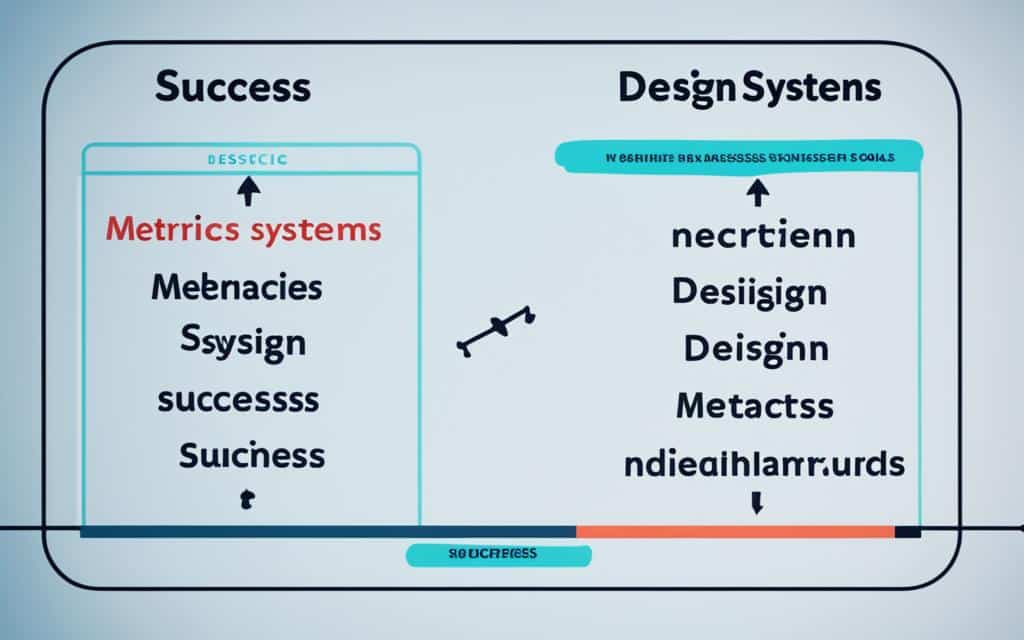Table of Contents
To ensure the optimal performance and cohesion of your design strategy, it is essential to measure the success of your design system. By implementing effective methodologies and monitoring specific metrics, you can evaluate the effectiveness of your design system in streamlining workflows, improving task completion times, and achieving consistency throughout your projects. In this article, we will explore seven quantitative and qualitative metrics that can help you measure the success of your design system.
Measuring the success of your design system is crucial for its effectiveness and continued improvement. It allows you to determine if your design system is meeting its goals and delivering the desired outcomes. By using metrics, you can gather valuable data that provides insights into how well your design system is performing. These insights can inform decision-making and optimizations that drive success.
Team Adoption
One of the key metrics to measure the success of your design system is team adoption. It is crucial to ensure that everyone involved in the creation of your app or website has access to and uses the design system consistently.
By conducting interviews, surveys, or using time-tracking software, you can gather data on team members’ usage of the design system, their feedback, and any obstacles they may face in adopting it. This data will help you identify areas for improvement and drive increased adoption of the design system within your team.
Gathering Data on Team Adoption
There are several methods you can employ to measure team adoption of your design system:
- Interviews: Conduct one-on-one interviews with team members to understand their familiarity with the design system, their usage patterns, and any challenges they may encounter. These interviews can provide valuable insights into individual experiences and perspectives.
- Surveys: Distribute surveys to your team to gather quantitative data on their usage of the design system. Ask questions about their frequency of use, ease of use, and overall satisfaction with the system. This data can help you track adoption rates and identify any areas where further training or improvements may be needed.
- Time-Tracking Software: Utilize time-tracking software to monitor how frequently team members access and utilize the design system. This data can provide an objective measure of adoption and usage over time.
Identifying Obstacles and Driving Adoption
Measuring team adoption is not only about collecting data, but also about identifying any obstacles that may hinder its adoption and usage. By understanding the challenges faced by your team, you can take the necessary steps to address them and promote increased adoption of the design system.
“Team adoption is fundamental to the success of your design system. Without widespread adoption and consistent usage, the benefits of the system may not be fully realized. It is crucial to identify any obstacles and actively drive adoption to achieve a cohesive and efficient design process.”
Regularly communicate the importance and benefits of the design system to your team. Encourage open feedback and provide training and resources to support their adoption efforts. Use the data gathered from interviews and surveys to identify areas where additional support or improvements are needed. By addressing these obstacles and actively promoting adoption, you can ensure that your design system becomes an integral part of your team’s workflow.
Key Metrics for Measuring Team Adoption
| Metric | Description |
|---|---|
| Usage Frequency | How often team members access and utilize the design system. |
| User Feedback | Team members’ opinions, suggestions, and experiences regarding the design system. |
| Challenges | Any obstacles or difficulties team members face in adopting and using the design system. |
| Training Needs | The level of training or support required for team members to effectively adopt the design system. |
The table above outlines key metrics for measuring team adoption of a design system. By monitoring these metrics and actively addressing challenges, you can drive increased adoption and ensure the success of your design system within your team.
Task Completion
Measuring task completion time is a crucial metric to determine the success of your design system. By comparing the time it takes to complete specific tasks before and after implementing the design system, you can assess the impact of the system on workflow efficiency. This metric allows you to evaluate how effectively your design system streamlines processes and enhances productivity.
Gathering qualitative data from your team members about their experience with the design system adds important insights to this metric. Their feedback can highlight areas for improvement, enabling you to streamline task completion and reduce any bottlenecks. By understanding their perspective, you can refine the design system and better align it with their needs and expectations.
Here are some key benefits of measuring task completion time:
- Identify areas of improvement: By comparing the completion time of tasks, you can identify any inefficiencies or challenges that hinder productivity. This insight allows you to make targeted improvements and optimize the design system to enhance task completion.
- Streamline workflows: Measuring task completion time helps you identify bottlenecks and areas that require optimization. By addressing these inefficiencies, you can streamline workflows and ensure smoother task completion.
- Enhance productivity: A well-designed system should improve productivity by minimizing redundant actions and providing clear guidance. Measuring task completion time can reveal where productivity improvements are needed, allowing you to further fine-tune your design system.
The Impact of Design System on Task Completion
Implementing a design system can have a significant impact on task completion. With a well-structured and consistent design system in place, team members can easily access the necessary design assets and guidelines, leading to faster task completion. The design system provides a unified framework for design decisions, reducing cognitive load and enabling team members to focus on the task at hand.
“The design system not only ensures consistency but also simplifies decision-making, expediting task completion and avoiding wasted effort.”
Furthermore, a design system eliminates the need to recreate design elements from scratch, saving valuable time. By providing reusable components and templates, team members can efficiently assemble designs and iterate more quickly.
Here is a table comparing task completion time before and after implementing a design system:
| Task | Before Design System (in minutes) | After Design System (in minutes) |
|---|---|---|
| Create UI mockup | 60 | 40 |
| Develop responsive layout | 120 | 90 |
| Review and provide feedback | 45 | 30 |
Design-to-Development Handoff
The design-to-development handoff is a critical phase in the design process and plays a significant role in the success of your design system. To effectively measure the efficiency of this handoff, it is essential to evaluate how well the design system facilitates the process. This includes assessing the ease of interpreting design files and the availability of ready-to-use code.
By measuring the design-to-development handoff, you can gain valuable insights into the impact of your design system on developer productivity and the overall speed of the development process. A well-designed and streamlined handoff process can save time, reduce errors, and enhance collaboration between designers and developers. This, in turn, leads to faster project delivery and improved product quality.
Gathering feedback from both developers and designers on their experience with the design-to-development handoff is crucial. Their insights can provide valuable information on areas that require improvement. By addressing any challenges or obstacles that arise during this phase, you can refine your design system to better meet the needs of both teams.
Design System Maintenance
The maintenance of a design system is vital for its long-term success. Ensuring that your design system remains up-to-date, accessible, and easy to use is essential to maximize its effectiveness and value to your team.
One aspect to consider when measuring design system maintenance is to understand who is responsible for updating the design system. Identify the individuals or team members who are accountable for making changes and ensuring that the system is kept relevant and aligned with evolving design requirements.
Additionally, it is crucial to assess the time it takes to make changes to the design system. Prompt updates enable your team to benefit from the latest design principles, user feedback, and industry trends. By tracking the speed and efficiency of updates, you can ensure that design system maintenance processes are streamlined and minimize any potential disruptions to ongoing projects.
Furthermore, communication plays a vital role in maintaining a design system. How updates are communicated to the team can impact their understanding, adoption, and utilization of the design system. Establish effective communication channels, such as regular meetings, newsletters, or dedicated platforms, to keep the team informed about important updates, changes, and best practices.
Gathering feedback from team members on the ease of use and accessibility of the design system is another crucial aspect of measuring maintenance. Understanding the pain points, challenges, and areas for improvement can help identify opportunities to enhance the system’s usability and address any implementation issues that may arise with future updates.
Overall, measuring design system maintenance enables you to evaluate the effectiveness of your processes and identify areas for improvement. By ensuring that your design system remains easy to maintain, up-to-date, and well-communicated, you can facilitate optimum team collaboration, enhance productivity, and sustain the long-term success of your design system.
| Metric | Measurement Approach |
|---|---|
| Responsibility | Identify individuals or team members responsible for updating the design system |
| Time for Updates | Track the speed and efficiency of making changes to the design system |
| Communication | Establish effective channels to communicate updates and changes to the team |
| Feedback | Gather feedback on the ease of use and accessibility of the design system |
New-Hire Onboarding
Measuring new-hire onboarding with a design system is a crucial but often overlooked metric for determining the success of your design strategy. The impact of a well-implemented design system on the onboarding process can be substantial, accelerating the integration of new team members and enabling them to contribute to projects quickly and efficiently.
Key factors to consider when measuring the effectiveness of your design system in onboarding new hires include:
- The speed at which new hires can start working on projects, indicating how well-prepared they are to contribute with the support of the design system.
- The duration of the onboarding process, with a shorter onboarding period indicating that the design system’s resources and documentation effectively facilitate learning and understanding.
- The level of training required for new hires to understand and utilize the design system, highlighting the efficiency and comprehensiveness of the system’s educational resources and support.
Gathering feedback from both new hires and their mentors or supervisors is vital to gain insights into the effectiveness of the design system during the onboarding process. This feedback can reveal areas of improvement and provide valuable guidance for optimizing the system to streamline the onboarding experience.
By measuring new-hire onboarding with a design system, you can assess the impact of the system on integrating new team members and identify opportunities to enhance the efficiency and effectiveness of the onboarding process.
User Satisfaction
Ultimately, the success of your design system can be measured by user satisfaction. Gathering feedback from end users on their experience with the design system allows you to assess its impact on usability, consistency, and overall satisfaction. By understanding how the design system enhances the user experience, you can make informed decisions to drive continuous improvements.
“User satisfaction is of paramount importance in evaluating the effectiveness of a design system. It determines not only the success of the system but also its ability to deliver positive user experiences. By prioritizing user feedback, designers can refine the design system to meet the needs and expectations of their audience.”
“The impact of a design system on user satisfaction cannot be understated. It influences the ease of navigation, visual coherence, and overall delight users experience when interacting with a digital product. Assessing user satisfaction provides invaluable insights for optimizing the design system and ensuring it consistently meets user expectations.”
– Jemma Thompson, UX Designer at Acme Corp
When measuring user satisfaction, it is important to consider various aspects of the design system that contribute to a positive user experience. Aspects such as:
- Usability: How intuitive and easy-to-use is the design system?
- Consistency: Does the design system maintain visual and interaction consistency across different screens and components?
- Efficiency: Does the design system enable users to complete tasks quickly and efficiently?
- Clarity: Does the design system provide clear guidance and information?
- Accessibility: Does the design system adhere to accessibility standards and make the product usable for all users?
Measuring User Satisfaction
There are several methods to measure user satisfaction with your design system:
- Surveys: Conducting user surveys allows you to gather quantitative data on user satisfaction. Ask users to rate their experience with the design system on a scale, providing valuable insights into their overall satisfaction levels.
- Usability Testing: By observing users interact with the design system in real-time, you can identify usability issues and gauge their level of satisfaction based on their ease of use and task completion.
- User Feedback: Encourage users to provide feedback through feedback forms or direct communication channels. This qualitative data provides valuable insights into specific pain points, areas for improvement, and overall satisfaction.
By regularly measuring and analyzing user satisfaction, you can identify areas for improvement and ensure that your design system continues to meet the needs and expectations of your target audience.
| Benefits of High User Satisfaction | Consequences of Low User Satisfaction |
|---|---|
| Increased user engagement | Low adoption of the design system |
| Positive word-of-mouth and referrals | Higher bounce rates |
| Improved brand perception | Decreased user retention |
Conclusion
Measuring the success of your design system is crucial to ensure its effectiveness and continued improvement. By implementing the metrics discussed in this article, you can gather valuable data on team adoption, task completion, design-to-development handoff, design system maintenance, new-hire onboarding, and user satisfaction. This data will provide insights into the strengths and weaknesses of your design system, helping you make informed decisions and optimizations to drive success.
Remember, evaluating your design system is an ongoing process, and regularly monitoring these metrics will ensure its continued success in supporting your design strategy. By continually measuring and analyzing the performance of your design system, you can identify areas for improvement, optimize workflows, and enhance user experiences.
In conclusion, the importance of metrics in design system evaluation cannot be understated. By measuring the success of your design system using the appropriate metrics, you can effectively gauge its impact on your team, your development process, and your end users. This data-driven approach will enable you to make data-backed decisions for optimization, leading to a more efficient and successful design system overall.
FAQ
How can I measure the success of my design system?
To measure the success of your design system, you can use various metrics such as team adoption, task completion time, design-to-development handoff efficiency, design system maintenance, new-hire onboarding, and user satisfaction.
Why is team adoption important in measuring the success of a design system?
Team adoption is crucial because it ensures that everyone involved in the creation of your app or website consistently uses the design system. By gathering data on team members’ usage, feedback, and any obstacles they face in adopting the system, you can identify areas for improvement and drive increased adoption.
How can I measure the impact of a design system on task completion time?
You can measure the impact of a design system on task completion time by comparing the time it takes to complete specific tasks before and after implementing the system. Additionally, gathering qualitative data from team members about their experience with the system can provide insights into any improvements needed to streamline task completion and enhance productivity.
How can I measure the efficiency of the design-to-development handoff process?
The efficiency of the design-to-development handoff process can be measured by evaluating how well the design system facilitates the handoff, such as ease of interpretation of design files and availability of ready-to-use code. Gathering feedback from developers and designers on their experience with the handoff process can further inform improvements to the design system.
Why is design system maintenance important in measuring its success?
Design system maintenance is vital for the long-term success of the system. By understanding who is responsible for updating the system, the time it takes to make changes, and how updates are communicated to the team, you can assess the effectiveness of your maintenance processes and identify areas for improvement.
How can I measure the impact of a design system on new-hire onboarding?
You can measure the impact of a design system on new-hire onboarding by evaluating how quickly new hires can contribute to projects, the duration of the onboarding process, and the level of training required. Gathering feedback from both new hires and their mentors or supervisors can provide valuable insights into the effectiveness of the design system in facilitating a smooth onboarding experience.
How can I measure user satisfaction with a design system?
User satisfaction with a design system can be measured by gathering feedback from end users on their experience with the system. This feedback should cover aspects such as usability, consistency, and overall satisfaction. By assessing user feedback, you can identify areas for improvement and ensure that the system continues to meet the needs and expectations of your users.
Why are metrics important for evaluating the success of a design system?
Metrics are important for evaluating the success of a design system because they provide valuable data on its performance and effectiveness. By regularly monitoring metrics such as team adoption, task completion, design-to-development handoff, design system maintenance, new-hire onboarding, and user satisfaction, you can identify strengths and weaknesses in the system and make informed decisions to drive its success.













